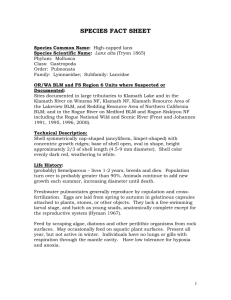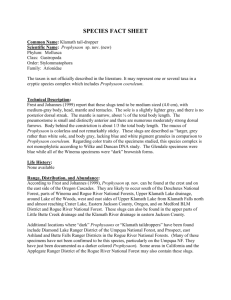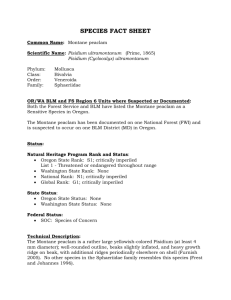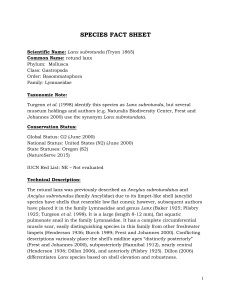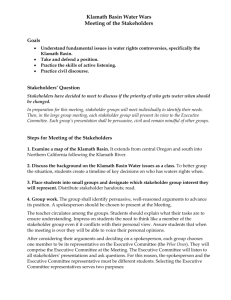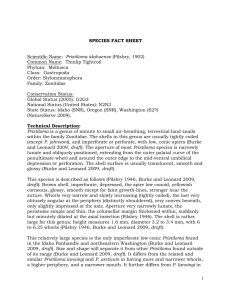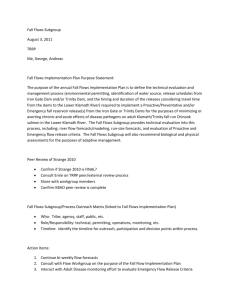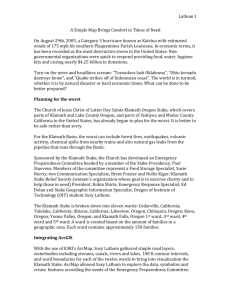Lanx klamathensis - USDA Forest Service
advertisement
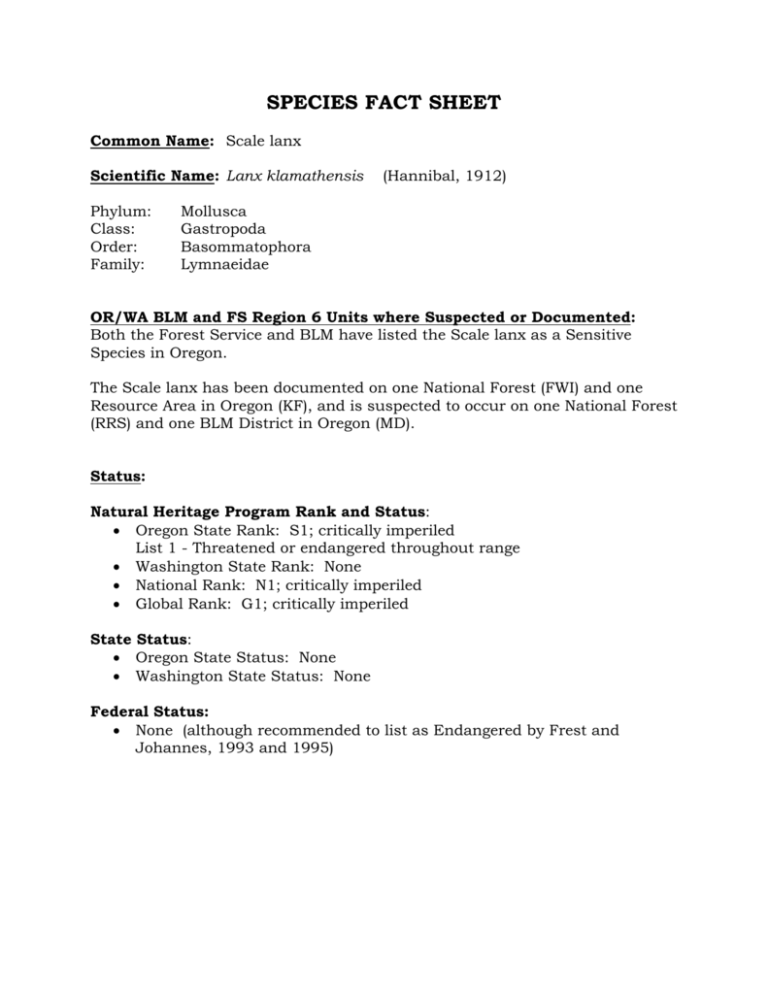
SPECIES FACT SHEET Common Name: Scale lanx Scientific Name: Lanx klamathensis Phylum: Class: Order: Family: (Hannibal, 1912) Mollusca Gastropoda Basommatophora Lymnaeidae OR/WA BLM and FS Region 6 Units where Suspected or Documented: Both the Forest Service and BLM have listed the Scale lanx as a Sensitive Species in Oregon. The Scale lanx has been documented on one National Forest (FWI) and one Resource Area in Oregon (KF), and is suspected to occur on one National Forest (RRS) and one BLM District in Oregon (MD). Status: Natural Heritage Program Rank and Status: Oregon State Rank: S1; critically imperiled List 1 - Threatened or endangered throughout range Washington State Rank: None National Rank: N1; critically imperiled Global Rank: G1; critically imperiled State Status: Oregon State Status: None Washington State Status: None Federal Status: None (although recommended to list as Endangered by Frest and Johannes, 1993 and 1995) Figure 1. NatureServe map of the conservation status of the Scale lanx (Lanx klamathensis) in the United States and Canada. NatureServe 2009. Technical Description: The scale lanx is a small freshwater limpet (length 10-12 mm), low patelloid, not convex; shell thin, height is approximately 4 mm, width slightly less than length; midline of apex slightly displaced anteriorly; base curving upwards both anteriorly and posteriorly from midline (Baker 1925, Burch 1989). The low and thin shell, many times wider and longer than high, is quite characteristic. Shell height vs. width in Lanx is better regarded as a species-level character (Frest and Johannes 1995). Life History: The Scale lanx is a freshwater riparian associate aquatic mollusk. The biology of this species is not well understood. Range, Distribution, and Abundance: Type locality is the south end of Upper Klamath Lake, Klamath Falls, Klamath Co., OR (Frest and Johannes 1995). The scale lanx was formerly likely widespread in the Upper Klamath Lake, Lower Klamath Lake, and Tule Lake basins in Oregon and California. It is now likely extirpated in California. It survives at a few spring-buffered sites in the Upper Klamath Lake area, including the Link River and localities in Winema National Forest and Upper Klamath Lake National Wildlife Refuge. The species may also occur in large streams and rivers draining into the Klamath Basin in the Butte Falls RD of the Rogue River NF, and in Medford and Klamath Falls BLM (Frest and Johannes 1995, NatureServe 2009). Lake-living species of Lanx appear to have been relatively widespread in some of the Oregon Interior Basin Pliocene-Pleistocene lakes, such as that once existed near Fort Rock. The scale lanx appears to be the last surviving lakeliving species of Lanx. Population trends in this species, both in terms of sites as well as numbers, are clearly downward. Significant range extensions or the location of large numbers of additional sites are very unlikely (Frest and Johannes 1995). Figure 2. Map of site locations for the scale lanx (Lanx klamathensis), from Frest and Johannes (1996) and BLM mollusk database (2008). Habitat Associations: The scale lanx is an aquatic mollusk restricted to large, spring-fed lakes and streams and limnocrene springs. A lack of gills or lungs typical of many pulmonates generally limit the habitat of the lancids to areas of unpolluted, cold, clear, well-oxygenated flowing waters, especially streams and areas with considerable spring influence. (Frest and Johannes 1995, Klamath 2003) Populations in lakes are limited to the vicinity of perennial spring input. The species, like all lancids, is an obligate perilithon grazer and lithophile, and occurs on cobbles and boulders, generally in areas with current and always at sites with oxygenated, high-quality clear water. The species is not found in areas with sediment or silt deposits, or in areas subject to low oxygen levels (Frest and Johannes 1995). Threats: (Frest and Johannes 1995, NatureServe 2009) Extensive human modification to rather specialized habitat is an ongoing threat to the scale lanx. Water allocation, water quality, nutrient concentration, eutrophication, impoundments, grazing, and habitat loss by conversion of springs for livestock and domestic usage are all threats to this species. Most of the large springs peripheral to Upper Klamath Lake were modified for log transport and are now part of irrigation projects; the species is absent from most areas so modified. Water rights issues due to inclusion in a major water reclamation project have also taken a toll. Even in the best remaining spring pools and spring-fed creeks, the scale lanx seems to be confined to limited areas with the best water quality. Most large springs and spring-fed pools are also heavily grazed. The species does not seem able to tolerate such disturbance. Conservation Considerations: Survey and map all Scale lanx occurrences. Protect this species’ habitat from further destruction and restore it when opportunities are presented. Monitor and assess activities for impacts on the Scale lanx and its habitat. Minimize or eliminate conversion of habitat for other uses. Monitor the effects of habitat changes on this species. The use of insecticides or herbicides may negatively affect this species. If insecticide or herbicide use is planned for areas where the Scale lanx occurs, utilize available resources to assess alternatives to their use. Limit agricultural runoff which may add nutrients and other pollutants to water Limit frequent water level fluctuations that cause increased turbidity Limit frequent water level fluctuations that impact the substrate Other pertinent information: This species commonly is found with a variety of other rare forms, including Pyrgulopsis archimedis, Pyrgulopsis n. sp. 1, Lyogyrus spp., Fluminicola spp., and Vorticifex klamathensis klamathensis (Frest and Johannes 1995). Survey Protocol While the scale lanx was not a Survey and Manage species, the following is a useful reference for conducting surveys of aquatic mollusks. Survey Protocol for Aquatic Mollusk Species from the Northwest Forest Plan Version 2.0 - October 29, 1997 http://www.blm.gov/or/plans/surveyandmanage/SP/Mollusks/acover.htm Preparer: Theresa Stone Umpqua National Forest 03 September 2009 Edited by: Rob Huff FS/BLM Conservation Planning Coordinator January, 2010 References Baker, H.B. 1925. Anatomy of Lanx, a limpet-like lymaeid mollusk. Proceedings, California Academy of Sciences 14: 143-169. Burch 1989. North American Freshwater Snails. Malacological Publications, Hamburg, MI. 365 pp. Frest, T. J. & E. J. Johannes 1993. Mollusk Species of Special Concern Within the Range of the Northern Spotted Owl. Final Report to Forest Ecosystem Management Working Group, USDA Forest Service. Deixis Consultants, Seattle, Washington. 98 pp. Frest, T. J. & E. J. Johannes 1995. Fresh Water Mollusks of the Upper Klamath Lake Drainage, Oregon. 1994 yearly report to Oregon Natural Heritage Program. Deixis Consultants, Seattle, Washington. Frest and Johannes 1996. Freshwater Mollusks of the Upper Klamath Lake Drainage, Oregon. Report to the Oregon Natural Hertiage program and Klamath Lake Project, USDO Bureau of Reclamation. Deixis Consulatants, Seattle, WA vii+ 200 pp. Klamath FERC Relicensing. 2003. Aquatic Mollusk Fauna in PacifiCorp’s Klamath Project Area. Document prepared for Aquatic Working Group Meeting; February 2003 NatureServe. 2009. NatureServe Explorer: An online encyclopedia of life [web application]. Version 7.1. NatureServe, Arlington, Virginia. http://www.natureserve.org/explorer. Taylor, D. W. 1981. Freshwater mollusks of California: a distributional checklist. California Fish and Game 67(3): 40-l63. Turgeon, D.D., J.F. Quinn, Jr., A.E. Bogan, E.V. Coan, F.G. Hochberg, W.G. Lyons, P.M. Mikkelsen, R.J. Neves, C.F.E. Roper, G. Rosenberg, B. Roth, A. Scheltema, F.G. Thompson, M. Vecchione, and J.D. Williams. 1998. Common and scientific names of aquatic invertebrates from the United States and Canada: Mollusks. 2nd Edition. American Fisheries Society Special Publication 26, Bethesda, Maryland: 526 pp.
